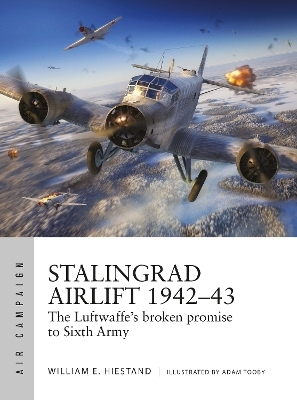
Stalingrad Airlift 1942–43
Osprey Publishing (Verlag)
978-1-4728-5431-5 (ISBN)
Luftwaffe chief Hermann Goering’s failure to deliver his promise to keep Sixth Army supplied at Stalingrad was one of the most hard-hitting strategic air failures of World War II. 300 tons a day of supplies were required to sustain the Sixth Army, flown in against a Soviet fighter force whose capabilities were rapidly being transformed. The Luftwaffe's failure left Sixth Army trapped, vulnerable and too weak to attempt a breakout.
The destruction of Sixth Army was one of the major turning points in World War II but the Luftwaffe’s crucial role in this disaster has often been overlooked. Some claim the attempt was doomed from the beginning but, in this intriguing book, author William E. Hiestand explains how the Germans had amassed sufficient aircraft to, at least theoretically, provide the supplies needed. Demands of aircraft maintenance, awful weather and, in particular, the Soviet air blockade crippled the airlift operation. In addition, the employment of increasing numbers of modern aircraft by the Soviet Air Force using more flexible tactics, coupled with Chief Marshal Novikov’s superior Air Army organisation proved decisive.
The Luftwaffe did eventually recover and mounted focused operations for control of limited areas of the Eastern Front, but overall it had lost its dominance. Packed with strategic diagrams and maps, archive photos and artwork of aerial battles over Stalingrad, and including bird's eye views of Operation Winter Storm and airlift operations and tactics, this title clearly demonstrates how the Luftwaffe lost its strategic initiative in the air.
William E. Hiestand has worked for over 30 years as a US Department of Defense analyst, focusing on military issues and serving in a wide variety of analytic, leadership and representational roles. He holds an MA in History from Cornell University, and has a lifelong interest in military history with a particular focus on 20th-century armoured and mechanized operations and Soviet military history. He lives in Virginia near Washington DC.
ORIGINS
The road to Stalingrad
Blau and Stalingrad
Operation Uranus
CHRONOLOGY
ATTACKER’S CAPABILITIES
The Luftwaffe on the Eastern Front
Doctrine, tactics, and logistics
Richthofen’s 4th Air Fleet
Luftwaffe fighters
DEFENDER’S CAPABILITIES
VVS: an air force in transition
A new commander and new reforms
Birth of the air armies
CAMPAIGN OBJECTIVES
Keystone on the Volga
Soviet objectives
THE CAMPAIGN
The turning point on the Eastern Front
November 24–30: establishing an airlift
Setting up the airlift – the task
The airfields and logistics, late November, 1942
Weather and flight operations
VIII Air Corps in command: December 1–11
The Soviet air blockade
Winter Storm (Wintergewitter), Thunderclap (Donnerschlag), and Little Saturn (Molnyy Saturn)
The airlift, December 12–23
The raid on Tatsinskaya, December 24
A new year, fading hope: January 1–15, 1943
The end: January 16–February 2, 1943
Milch on the scene
Milch and the airfields
AFTERMATH AND ASSESSMENT
FURTHER READING
INDEX
| Erscheinungsdatum | 09.01.2023 |
|---|---|
| Reihe/Serie | Air Campaign |
| Illustrationen | Adam Tooby |
| Zusatzinfo | Illustrated throughout with around 60 photos and at least 14 pages of colour illustrations |
| Sprache | englisch |
| Maße | 184 x 248 mm |
| Themenwelt | Geschichte ► Allgemeine Geschichte ► 1918 bis 1945 |
| Geschichte ► Teilgebiete der Geschichte ► Militärgeschichte | |
| Sozialwissenschaften ► Politik / Verwaltung | |
| ISBN-10 | 1-4728-5431-4 / 1472854314 |
| ISBN-13 | 978-1-4728-5431-5 / 9781472854315 |
| Zustand | Neuware |
| Haben Sie eine Frage zum Produkt? |
aus dem Bereich


